Issue Number 56, Spring 2022
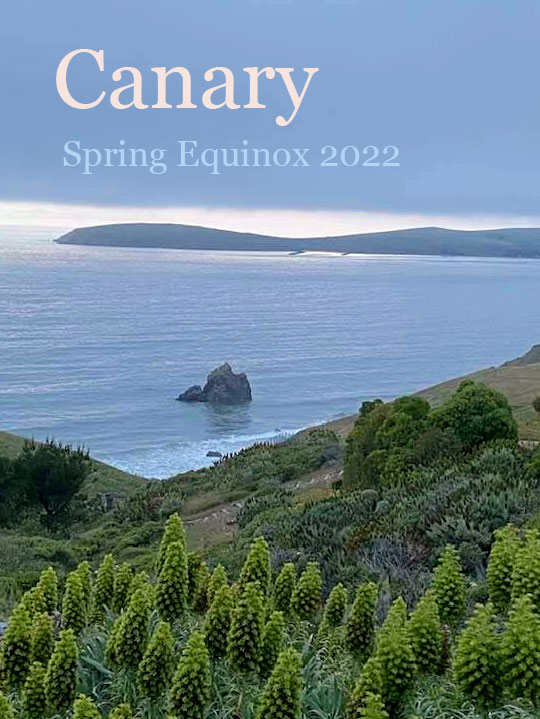
Contents
- Piece of the wind by Chris Duffy
- The Old Heron, Rising by Cathryn Essinger
- In Defense of the Silver Maple, by Cathryn Essinger
- Where Is the Upflying? by Nadia Colburn
- Succession by Ellen Parent
- Decomposition by Andrew McCall
- Tell Those to Come by Carson Colenbaugh
- Elegy for the Polar Ice Caps by Laura Budofsky Wisniewski
- Owling by Moira Magneson
- My Eighteen-Month-Old Daughter Talks to the Rain as the Amazon Burns by Dante Di Stefano
- Adaptation by Mark R. Moe
- this morning by Shelley Chesley
- of loons and lakes by Shelley Chesley
- Day Tour by Kenneth Chamlee
- The Tigers by B.J. Wilson
- Sweet Seed in the Rock by Deborah Gorlin
- Here a Vernal Pool Reflects by Joan Hofmann
- Hubris by Linda Briskin
- Compassion for Crows by Gregory Lobas
- Yatu Moon by Gregory Lobas
- Lawn Story by Sara Barnett
- Bird Calls by Marcelo Sosa
- Talistree by Valerie Sopher
- I’ve been told that once by Nichole Brazelson
- Clouds by Joan Gibb Engel
- Thin Places by Penny Harter
- In Greenland the Ice Sheet by Susan Cohen
- Erosion by Janet McMillan Rives
- Gifts by Janet McMillan Rives
- Sprouting Wand by Anna Laura Reeve
- Playing the Washboard by Anna Laura Reeve
- Arbor Day by Rebecca Lawton
- The Grief of Crows by Maggie Wadey
- Sand dunes by D.S. Maolalai
- The First Last Days of Bombus Affinis by Staci Mercado
- Sleeping Deer in the Afternoon by Jerome Gagnon
Archives: by Issue | by Author Name

Piece of the wind
by Chris Duffy
Chris lives in New Jersey near the Hudson and Hackensack Rivers. This poem was written on a footbridge along the Saddle River which runs over six miles through several towns.

Here, in early spring
The green pushes forward
With such worthy ambition
While the golden butter cups
Like little pocks of gold
Are freckled plenty
Along the banks of the brook
Living as they see fit, which
How can anyone argue
Is other than happily,
Which is admirable,
Which is, at times,
The most difficult thing to be.
Still, right there
When your eyes open to it-
The springing out of spring,
The unfolding
As the unfolding of hands,
The happiness,
Which is like unburdened childish laughter-
Contagious and soul warming -
There you are,
Wholly, and a piece
Of the wind, which
Isn’t that everything?
© Chris Duffy
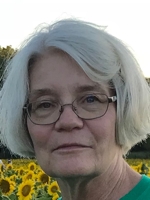
The Old Heron, Rising
by Cathryn Essinger
Cathryn lives in the Ohio River Valley close to Spring Creek and the Great Miami River.

Spring has arrived with the old clichés intact--
fragile and persistent, billing and cooing.
Beside the road, the bones of the little fox tangle
with new grass, and once again the creek gurgles
with snow melt; watercress blooms in the shallows.
The old heron who refuses to migrate, the one
I watched all winter, huddled beneath windbreaks,
standing in pools rimmed with ice, understands
that beginnings always foreshadow their ends.
Once again, he is preening his winter blues, checking
the skies for that first glimpse of a pretty wing tip,
enough to make his old heart rise and rise again.
And so he waits…loneliness still part of his intrigue.
Soon, there will be the release of summer, and for
a few days, in the cracking of the eggs, in the cries
of the young, there will be the bliss of belonging.
Previously published in Spillway, and in the book The Apricot and the Moon by Cathryn Essinger
© Cathryn Essinger

In Defense of the Silver Maple,
by Cathryn Essinger
Cathryn lives in the Ohio River Valley close to Spring Creek and the Great Miami River.

much maligned nowadays as a water loving leech,
a tree whose canopy spreads so widely
that it fails in every storm.
Its roots seek out our septic systems, burrow
into the fabric of the subdivision,
contaminate our drains.
But these trees made the suburbs a place
to live, gave shade while there were
still lawns to be planted,
and provided children with a gazillion winged
achenes, whistles, and whirly gigs
to spin in muddy puddles.
Never mind that blight will level the chestnuts,
take down the elms, that even the ash trees
will succumb, these maples
persisted, despite asphalt and strip malls,
their roots tilting the sidewalks
of our childhoods.
Today their young crowd our flower pots,
overtake gardens, sprout between
the cracks in the Costco lot.
As I slop them out of the gutters, I level
whole forests, take down kingdoms
built on chlorophyll and silt,
needing nothing more than a bit of grit
and a splash of sun, each seedling
obeying orders to grow
where you are planted, to tough it out,
to believe in dynasties, to thrive
despite slander and adversity.
© Cathryn Essinger

Where Is the Upflying?
by Nadia Colburn
Nadia lives on the land of the Masachusett people not far from the Quinobequin River and close to the smaller Menotomy River, where there were once plentiful fish and fishing.
Whole flocks of geese in my childhood honking their way North—
The streets dirty with pigeons—
The sky blackened by starlings: each small, pointed wing so close to another’s it was just a blur—
Now only sparrows in the thick shrub branches—thousands of them—so many more
than we humans—twittering at first light.
And yet, how many have been lost?
Three billion birds are missing.
We wake to so many forms of emptiness;
so many forms of loss greet us in our sleep.
In my childhood, I thought the world I’d entered
would be the world I’d exit.
There, in the poplar, one bird sings—

© Nadia Colburn
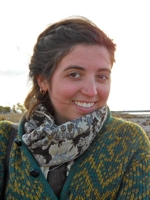
Succession
by Ellen Parent
Ellen lives in the Northeast Kingdom, on a granite hill formed alongside the White Mountains during the Acadian Orogeny 100 million years ago. Her home is surrounded by tamaracks and sugar maples, chickadees and an Abenaki path now known as Route 2.

My bright memory of coyotes
slipping through damp milkweed
through high meadows
just twenty years ago--
gone.
Eighty white pines
fill the fields now.
Now roots plow the old soil.
In the beginning these hills burst naked
from the earth’s first churning,
cultivated postglacial coats
of spruce and pine,
of oak and pine--
Green exhalations breathed a thousand
thousand years--
But every tree fell
to sixty seasons of a log baron’s
boom and a two-man saw.
Now baron, blade-- they’re gone, too.
And me, passer-by, brief beating heart--
Do I mourn my lost light,
blown milkweed, coyote ghosts
chasing field mice down the valley?
Or do I bow to these shadows,
dark press of branches and dapple,
the wild that keeps coming back?
© Ellen Parent

Decomposition
by Andrew McCall
Andrew lives near where glaciers stopped their flow 10,000 years ago in Ohio -- moraines and gorges to the east, and glacial scour to the west. He is in the Muskingum River watershed.

It’s right,
to be left in a shroud
wrapped tight
like a caterpillar
waiting to split its skin
in metamorphosis.
Throw away the steel box,
the fluids that make cells arrest,
mourners, the alb and cincture,
the car that carries the body.
Love, do this instead -
drag me in a litter of wicker
to that patch of bloodroot
and its crenulations of leaf,
that strange redeemer that,
instead of eating only sun,
might find my feast beyond
its red rhizhomes.
Don’t unbind me
even if they order you.
Let them try and find me -
sucked up in lianas, in the
beech’s green teeth,
in the ivy that no one
wants to touch.
© Andrew McCall

Tell Those to Come
by Carson Colenbaugh
Carson grew up on the banks of Proctor Creek and is currently a horticulture student in the watershed of the Savannah River. His favorite plant is striped wintergreen, which he searches for beneath the leaf litter.

Pouring warm tea in an old tin cup,
picking mint from the windowsill—
it's rainy today and I’ve
forgotten my jacket; the things we do
to survive.
Green glass and ceramic mugs
and all the other things they’ll dredge from
the midden piles of our generation one day,
just as we dig out old shells and
arrowheads, tools of the great harvesters.
Foraging, seeking, making fire—
picking mushrooms in the sprinkling
afternoon with my friend who knows which
ones we can still eat
after all these years.
© Carson Colenbaugh
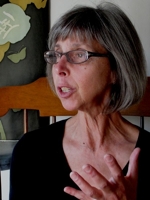
Elegy for the Polar Ice Caps
by Laura Budofsky Wisniewski
Laura lives in the central Lake Champlain Valley, in the Lewis Creek Watershed, a lovely little tributary of which runs through her land. The plants and wildlife of Lewis Creek are currently being threatened by a drastic rise in housing and commercial development.

There are only twelve of us left. Four boats.
The Old Man says help the pregnant girl
into the one that’s been blessed,
but she climbs in by herself.
I look back
as if there were still a village.
All known things have already floated
out toward the horizon.
So this is what it’s like
to leave,
with no one waving goodbye.
We have food and water for seven days,
and our fishing lines.
After that, if it doesn’t rain, we’ll die.
The Grandmothers are praying,
faces lifted, voices rough as straw.
They are praying the long ago story
of when the Earth was a brand new child
scrubbed clean in the salty sea, but in that story
the ocean was clear to the bottom,
filled with magical dolphins
and the very air
could sing.
© Laura Budofsky Wisniewski
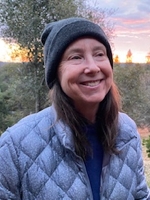
Owling
by Moira Magneson
Along with gray foxes, quail, mule deer, and coyotes, Moira lives on a parcel of clay-red earth in the Sierra foothills. An ephemeral creek threads through her land, a reminder of the nature of impermanence.

The naturalist took us owling
at twilight up in the green hills
of American Canyon. I knew
the place—a deep cleft in the land horse
stables dairies. We stopped
at a stand of eucalyptus. A fine
rain coming down. I could hear the river
of cars running parallel on the interstate—
swoosh swoosh swoosh
We were told a Great Horned owl lived
nearby high in the oily bushy menthol.
I scanned the treetops.
The man pulled a little bundle from his trouser
pocket—a field mouse tethered
with a long leash of string.
Anchored to a heavy stone
the tiny creature took off
scurrying to the end of her world
where she stopped short quaking. Our guide
giddy with the certain telos
of his design the owl descending
from his perch a terrible winged minotaur. But there
on the earth tangled in twine the bird also
suffered whirlwind gathered up
with leather gloves metal band crimped
on his leg identified accounted for let go.
I turned walked back to the truck got in
huddled on the passenger side waited
and wondered for all our lives—what marvels
we were wild innocent damned.
© Moira Magneson

My Eighteen-Month-Old Daughter Talks to the Rain as the Amazon Burns
by Dante Di Stefano
Dante lives near the confluence of the Susquehanna River and the Chenango River between the Endless Mountains of Northern Pennsylvania and the Finger Lakes of Central New York.

this little lark says hi
to the rain—she calls
riveras she slaps
the air with both wings—
she doesn’t know pine
from ash or cedar
from linden—she greets
drizzle & downpour
alike—she doesn’t
know iceberg from melt—
can’t say sea level
rise—glacial retreat—
doesn’t know wildfire—
greenhouse gas—carbon
tax or emission—
does not legislate
a fear she can’t yet
feel—only knows cats
& birds & small dogs
& the sway of some
tall trees make her squeal
with delight—it shakes
her tiny body—
this thrill of the live
electric sudden—
the taste of wild blue-
berries on her tongue—
the ache of thorn-prick
from blackberry bush—
oh dear girl—look here—
there’s so much to save—
moments—lady bugs—
laughter—trillium—
blue jays—arias—
horizon’s pink hue—
we gather lifetimes
on one small petal—
the river’s our friend—
the world: an atom—
daughter: another
name for: hope—rain—change
begins when you hail
the sky sun & wind
the verdure inside
your heart’s four chambers
even garter snakes
and unnamed insects
in the underbrush
as you would a love
that rivers: hi—hi
© Dante Di Stefano
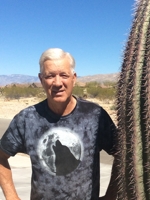
Adaptation
by Mark R. Moe
Mark lives in the stark wonderland of the Sonoran desert, a land of infinite cacti, rolling hills, arroyos, and wrinkled mountains. It’s a land you learn to love for its tenacious beauty.

when you strain to see
the grouse that blends so perfectly
into shreds of leaf and bark, made
mad mosaic by dappled shade
and dancing light, it may
strike you that nature plays
a benign game of interference
belying her indifference
then take another, closer look
to understand what you can’t see -
all the other grouse it took
to achieve invisibility
© Mark R. Moe
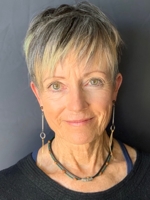
this morning
by Shelley Chesley
Shelley lives in the Cascade Creek watershed north of San Francisco, among redwoods, coyotes, foxes, deer and alongside one particularly outstanding elder Japanese Maple.

taken down
stunned by redwoods drunk on mist
the pacific northwest you hazard
but ‘you can’t get here from there,’ it’s
these trees, this mist
that treetop’s defiant sprig
crookedly upright, middle
finger of imperfect presence
standing in for all creation
you cannot help but love
its claim
soft diaphanous white on the move
obscures the view,
reveals it for
one… no one
i teeter on
invisible edges only in my mind
neither presence nor a b s e n c e
i’m dizzied
still, crows move in and out;
give me back my
body
© Shelley Chesley

of loons and lakes
by Shelley Chesley
Shelley lives in the Cascade Creek watershed north of San Francisco, among redwoods, coyotes, foxes, deer and alongside one particularly outstanding elder Japanese Maple.

you are lake launching skyward
wings keep oar beats
unfit for land
your water nature rip-
ples with runaway clues,
rife in the lusty fear of fishes
lady lake shape-shifts—frogs pulse shiny
in her palm—she
revels in shadow-savvy
flitting fish schools
suns her bottom in the shallows
of mud lazy places
but you loon you
leave her behind
laboriously, fitfully claiming sky
like old broken Willie the pond jumping plane
I’m shore bound
you make your peace with air
and haul yourself away
till May’s spring spell obliges—
you track my way again
to scrape a nest both moist and dry, you
covet that edge where liquid meets form
checkered breast rests half in water
where invisible loon mothers tune in humming
privy to the ways of lakes and loons
ready to mount their laugh-ridden opera
as lady lake laps close
© Shelley Chesley

Day Tour
by Kenneth Chamlee
Ken lives at the edge of the southern Blue Ridge Mountains near Asheville, N.C., in the Boylston Creek watershed and is often found in Pisgah National Forest. He finds comfort in campfires, photography, and landscape art.

Geese fly over, honking their klaxons
like a caravan of Model T’s, then drop and rally
in the neighbor’s pond, raucous and flapping.
A few step out on the weedy bank
to browse and haggle like it’s market day
at every pond and field and stubble-yard,
but most circle like a motor club cruising
a town square, proud owners in black
chauffeur’s caps and white scarves.
Soon all lift into a skein of order and gabble,
wheeling a smooth county circuit
over old roads mapped in their heads.
© Kenneth Chamlee

The Tigers
This was the winter tiger: not the svelte, languorous creature of long grass and jungle pools, but the heavy-limbed sovereign of mountains, snow, and moonlight . . . —John Valiant
by B.J. Wilson
B.J. lives in the Coosa River watershed in northeast Alabama.

Siberian tigers, now known as Amur after the river that winds through Russia’s Far East, can get nine-to-ten feet from head to tail, the biggest cats in the world. I’d driven over two and a half hours to see them and, once inside the zoo, I broke into a jog as the globular drops began to fall.
Under the shelter of the tiger exhibit, summer employees gathered in soggy polos. One young man had a walkie-talkie, and an older man with a white pony-tail and handlebar mustache, also a worker, stood alone. Drenched parents and small children made up the rest. On the other side of the window, the tiger lay in the open rain, lightning flickering above her.
The young man with the walkie-talkie entertained. With a small crowd around him, his voice delayed under the enclosure and pounding rain, he talked about the tiger. I’ve forgotten her name: perhaps Bessy or Irene. When he got to the part on how she once crept into the pond and sprang toward the glass before us, these things happened: the tiger slid through the tarn, hidden to her neck, the water riddled with raindrops. Then she emerged into air.
She swang her paws at the glass where a toddler had his back turned. Once parents realized placing their children by the window enticed the tiger, they lined them in a row, inviting a mountain of a predator into their lives.
With all her ferocity and frustration, the tiger bit at the glass as if it were ice, dreaming of an East she’d never see, its blue moonlight gleaming off snow coating the taiga. Parents snatched their children away and sprinted into the rain.
The man with the handlebar mustache rushed to the glass to see if it had cracked. Instead, on the other side of the window, he pointed to a tooth deposited in the mud, root and blood of it, shards of wood around it from where the tiger had bitten into the window frame.
“I guess we can’t let people do that anymore,” he muttered.
The younger man with the walkie-talkie used it, then ushered the rest of us away.
Mass produced wooden tiger heads in the gift shop spooked me, their disembodiment. Key chains with wide tiger eyes and those tiny, pinpointed pupils.
The procession continued, snow cones and elephant rides, summer puddles evaporating, rain dripping from landscaped trees and shrubs along paths with arrows.
As I passed the tiger enclosure on my way to the exit, I noticed that the tooth was gone, as was the female it belonged to, and the new tiger was different. Bigger. Much bigger. Making rounds throughout his plot of replicated earth, he paid me no mind as he passed. He knew they were both entitled to much more, his pugmark in the mud big as a pot lid, as two million years. Streaks of lightning, far off, shattered the sky. Another storm on its way.
© B.J. Wilson
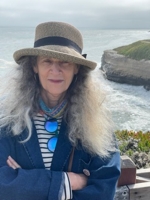
Sweet Seed in the Rock
by Deborah Gorlin
Deborah lives in the Pioneer Valley near the Fort River, the longest free-flowing tributary of the Connecticut River, where attempts have been made to save the endangered freshwater dwarf wedge mussel.

Once upon this time, vaulted deep
within the mountain, bundled
in foil, sealed in boxes set in rows,
the seeds in their Doomsday dorm,
run in place like dogs dreaming
of chasing squirrels and deer. Exiled,
they long for their former homelands:
Syria and Chernobyl. North Korea,
Palestine, so many places, where war,
Round-up, weather, fires, Bayer, politics,
disappeared them. Saviors hope to hide
them here from harm, to keep them secret
like Anne Franks in attics, spares
to their heirs, to sock them away under
the thick down mattress of ice
and snow in a fairytale climate itself
imperiled, why just yesterday, a melt,
from rising temps. Among the 20 million
samples, some heirloom and ancient grains,
farming from its very origins! as far back
as the Fertile Crescent, the cereals, emmer
from Sumer, bitter vetch, flax, hulled barley.
A Judean date palm nicknamed Methuselah.
For these fetal plants, sleeping Rip Van Winkles,
future paused, passes them. However remote,
no Zoom for them, holed up in their North Pole
nest egg, tiny kings in the mountain waiting it out,
until their return to rule. Dirt sick, they wish
to hitch one random ride of vagrant wind
to burr animal fur, to squirt out of fox’s scat,
for sun light’s long arms to lift them gently up
from their dark cribs, for water to nurse
them with its transparent milk, to be
of use, to grow below, whatever their destiny,
carrots or celery, beets or cabbage, come
what may, hurry, please, to give them
a life while there’s still earth.
© Deborah Gorlin

Here a Vernal Pool Reflects
by Joan Hofmann
Joan grew up knowing the Schuylkill and Delaware rivers of Pennsylvania. She now spends time hiking and walking along the Farmington River and on hills and trails in Connecticut where she lives in love with the seasons, flora and fauna of New England and the Atlantic coast.

In concert with other pools, it
renders the forest floor into
abundance, thrilled in moss.
Framed by lichen-rich trees,
straight trunks reach skyward while
windswept, downed kin lie askew.
Carpeted in spring greenness,
ephemeral shallows here today
may disappear tomorrow.
These are but temporary depressions,
vessels without visible ingress or
egress, seasonal ponds flooding up.
Enough for amphibian attraction:
spotted salamanders, shrimp nymphs,
wood frogs, among the lovers of elusive.
To this place I walk miles each day
to be among the still pools. Holding my
breath at the outcrop to scan landscape:
Who is still here? Which of you has
departed? Which wanes into another
form of itself, passes to vanished?
© Joan Hofmann

Hubris
by Linda Briskin
Linda's back garden in the Taddle Creek watershed was once a part of Taddle Creek, and water still occasionally bubbles up. The 25-mile-long Seguin River, mentioned in Hubris, empties into Parry Sound on Georgian Bay. The river's name comes from the Ojibwe word ziigwan meaning "spring."

The early morning sun paints the sky melting shades of orange, red and pink. From the top of the hill, the Seguin River is a sleeping snake. Rising and curling, the mist on the water entices. At the dock, I slip the kayak into the river. It cleaves the water with ease and grace. The paddling is almost effortless, hypnotic, a meditation.
A blue heron—blurred by the mist—stands tall and still, a sentinel. With sudden majesty, it lifts off, wings wide, air filled with the hum of movement. Tag alders clutter the banks, their twisted branches mirrored in the calm river. The reflections beckon, and then shimmer and scatter as I push and pull with the paddle. I breathe in the moment.
A dragonfly lands on the edge of my paddle. Camera ever ready, I capture the tracery of its four wings, and its delicate legs in unlikely balance.
I don’t know the name of this dragonfly. But I’ve always been fascinated with the categorization of Odonata (which include dragonflies and damselflies), originally by the Swedish botanist Carolus Linnaeus in the 1700s.
The Dragonfly Society of the Americas indicates that more than five thousand species have now been identified. A small chart on my fridge lists an arbitrary selection. The dates of their ‘discovery’ a reminder of the long history of human-dragonfly engagement.
Hetaerina titia, Smoky Rubyspot, named in 1773
Calopteryx maculata, Ebony Jewelwing, named in 1805
Somatochlora albicincta, Ringed Emerald, named in 1839
Triacanthagyna trifida, Phantom Darner, named in 1842
Erythrodiplax fervida, Red-mantled Dragonlet, named in 1848
Neurocordulia molesta, Smoky Shadowdragon, named in 1863
Macrothemis inequiunguis, Jade-striped Sylph, named in 1895
Palaemnema domina, Desert Shadowdamsel, named in 1903
The names are evocative, resonating with stories. I like to recite them as a charm against the anxiety of the world, tangling my tongue around the delicious and impossible Latin syllables, delighting in the English lyricism of shadowdragons and jewelwings. Yet I am aware of the self-indulgent tendency to claim ownership of the natural world through naming.
The dragonfly lifts off the paddle and spirals away. The sun climbs in the sky, the mist dissipates. The mystical Otherworld of early morning vanishes. The kayak butts up against an obstruction of woven branches of birch and alders. The river rages against the restraint of this beaver-built dam, mourns lost movement. I hear its plea to be released.
I swing my legs out of the kayak and plant my feet on the shifting bottom of the shallow summer water. Arms in rhythm with the longing of the river, I dismantle the narrowest opening of the dam, weeds thick, logs moss-heavy. Heaving rotting branches unsettles old scum and stagnant pools, and releases a fetid stench of decay.
A flutter of dragonflies. Their elegant wings mesmerize with light-touched iridescence. A green darner lands on my arm—perhaps a sign of good luck. Joined by a Calopteryx damselfly with her blue etching. A small blessing.
Suddenly many dragonflies, flittering. In distress?
I wrench one final branch from heavy sand. Then surging water rushes free. Standing in the river, inhaling the sun,I struggle—with pleasure—to keep my balance. The kayak now passes easily through the new opening.
On my early morning paddle the next day, I discover the dam is rebuilt. The beavers may be ingenious but I’m frustrated with obstacles blocking the smooth flow of the river. I’m frustrated with the beavers taking down so many trees. I’m frustrated that I can’t get my kayak through the dams.
I begin a search for ways to discourage beaver activity. Instead, I chance upon the non-profit Beaver Institute whose goal is to support the beaver’s critical role in creating climate-resilient wetlands. The Institute calls for humans to co-exist with beavers and embrace the indigenous wisdom of living in harmony with nature.
I learn that beavers are a keystone species on which others in an ecosystem depend. Beavers do not kill trees but coppice them and stimulate new growth. They open up the tree canopy and let in the light. The beaver dams create wetlands and an entire food chain for the otters, water shrews, voles, birds, dragonflies and breeding fish. The cool deep pools are sanctuaries for dragonflies who cannot exist in polluted habitats. The beavers share their winter lodges with muskrats and mice. They welcome diversity and enrich the environment. A group of beavers is actually called a family.
I used to see the beavers as giant destructive rats; now I now appreciate their innate commitment to caring for the environment. The contrast between the generosity, ingenuity and reciprocity of beaver families, and the self-interest, rage and violence that permeate human communities is deeply disturbing. I want to be part of a beaver-like family that does not clearcut, build walls and fences to keep others out, and callously pollute. I want to be part of a family that supports community and reveres nature.
I fear the Anthropocene epoch which is marked by global warming, habitat loss, and toxic microplastic particles in the atmosphere and oceans. The numbers fill me with despair—the magnitude beyond comprehension. According to Conservation International, more than seventeen billion pounds of plastic are dumped into the oceans each year—the equivalent of 57,000 blue whales. The Millennium Ecosystem Assessment estimates an unprecedented species extinction rate of twenty-four a day. Our sense of entitlement is destroying the ecosystem.
I am responsible too. With careless arrogance, I treated the beaver dams as an impediment to my desires.
Humbled, I recognize now the reverence of the river for the power of woven branches, birch tangles, stones and sand. I understand the distress of the dragonflies at the disruption of the calm surface of their pond.
The dragonfly a harbinger.
My longing, I realize. Not the longing of the river.
© Linda Briskin
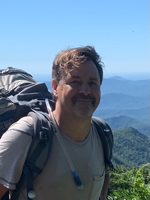
Compassion for Crows
by Gregory Lobas
Greg started out on the North Coast area of the Great Lakes but has since migrated to the foothills of western North Carolina in the First Peaks of the Blue Ridge Mountains.
They fly by the murder like tatters of midnight
swearing oaths against the daylight
they cannot restrain and so they complain,
dark sentinels across the dry fields of a shared futility.
I know a woman named Talks-to-Crows.
From the forest floor she stutters their same
coarse-throated caw-caws calling crows from the fields
to wheel above the treetops frantic to find
their crow-calling mother.
Crows she smiles, just like to be noticed.
God notices.
God sees everything. God sees
one crow standing silent and alone in my drive
at the bottom of the hill, near the trees, around the bend,
set upon the gravel like a bust of Socrates.
God sees me stop my victory-red pickup
the size of 10,000 crows, sees us lock our eyes, the crow
refusing to fly or hop aside like a proper crow should.
Black.
Crow-black.
Beak-black
feet-black
eye-black
obsidian brilliance
probing the depth-black
of my compassion for crows.
It waits, and I feel the prick of its dour expectation.
Should I get out of my truck and wait with it?
But God sees me ease my tire blacks
around the crow, black between,
undeterred from the press of errands
black of no consequence.
God sees the crow raise its black countenance
to my undercarriage black passing over,
the crow dwindling into the nothing of my rear-view mirror.
The absence of a crow follows me to town,
to the hardware store for nails, the grocery for bread.
I fill up with its absence at the gas station.
An empty hour later, my tires crunch the gravel
of my drive. and I find it could wait no longer, for crows
may fly by the murder, but they die alone.
Only with its death do I begin to see as God sees,
carnation, emerald, lavender,
feathers like shimmering flowers
limp and iridescent
on the stone of my driveway.
God sees me wonder if God could be a crow.
Would I have waited an hour even so?
God sees every crow.
But I, late, have come
to see this one.

© Gregory Lobas

Yatu Moon
Curacao
by Gregory Lobas
Greg started out on the North Coast area of the Great Lakes but has since migrated to the foothills of western North Carolina in the First Peaks of the Blue Ridge Mountains.

I sit on the veranda
light a cigar,
close one eye
and sight-in the rising moon
with a cactus flower.
I don’t know why I do it.
A symmetry, I suppose,
to hold the line-of-sight just so,
and view the flower-colored
moon drenching the yatu’s
moon-colored flower.
How to endure the limestone
rubble of our lives:
Be a cactus.
Grow shocking
spiny florets, skin
impenetrable
to trade winds.
Labor a full year
to produce this one
pure elegance
in spite of it all.
Many things live tonight
that will not live again.
I will not be the same
tomorrow, and this
flower will,
by morning,
be wilted and chewed
by an iguana like a cud,
its one night of splendor
a dark blot in the detritus
beneath the furnace
pillars of the yatu landscape.
© Gregory Lobas
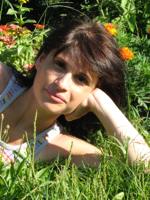
Lawn Story
by Sara Barnett
Sara has lived on both American coasts and now happily narrows between the East and Hudson Rivers.

Out by the stump
when I was small
became a table
I would lay my china cups
pretend to
ladle
While my father,
taking seed that would be flowers,
sowed my initials in the grass to bloom in blue.
These are the first to rise come springtime
little cockle bells of azure
spelling enchantment and tolling true love true
This fall when I visited in November
my father’s pride and joy: his row forsythia
was fallow
Save one sprung up in all its yellow.
out by the stump,
where we were young.
Where still do
grow the cockles,
where in autumn an April bush is burning
and I kid you not -
adjacent to the fallen timber
(that same old stump where we would linger)
On that mountain road,
Arisen new! has come along
An apple tree.
© Sara Barnett
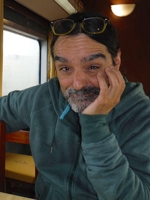
Bird Calls
by Marcelo Sosa
Marcelo lives in the Colorado Rockies above 8000’, where chickadees whistle, woodpeckers thrum, swallows chatter and juncos trill in the relative security of aspen trees, Douglas fir, and ponderosa, spruce and lodgepole pine.

When I hear birdcalls out of place (warblers chipping in a store, flycatchers whistling on a street), I crane my neck to pick up patterns in the shifting seasons—clues in the trees, on the ground, in the sky, in water. I recall crosswalk signs from youth: Stop. Look. Listen. Amid the prevailing COVID haze it’s easy to get distracted by the illness of my species, ignore the intuition of the “more-than-human” peoples and places of this world (to quote Robin Wall Kimmerer).
Early in September, 2020, months into stay-at-home, my partner Shelly and I finally felt the need to “fly” away. Resident birdlings had fledged, and many fellow travelers would soon begin their long migrations—cranes, geese, hummingbirds—puzzling over fluctuating continental pathways in the face of intensifying climate transformation; flying farther every year to arrive at their seasonal destinations.
Habituated to masks, social distance, and the changing colors on the COVID dial dashboard, we snuck away from the refuge of our cabin in the mountains west of Denver. Braving our customary autumn migration to camp among the aspens, we added a visit to the town of Leadville to help memorialize the April death (unrelated to, but still affected by the virus) of Shelly’s longtime friend, Char.
We added, too, a couple of Forest Service cabins to explore a bit of FS history as we went, but in 2020 everything was different; everything felt wounded, urgent and absolute at every turn. September still beckoned in crisp days, starry nights, and eruptions of Autumnal forest glory, but Colorado could go into lockdown at any moment, forests could catch fire, the Leadville memorial cancel due to risk and sudden cold.
So much of that year had been surreal, like a story told of another time, even while we lived it. The west coast burned in September: massive smoke-plumes blanketed the Rockies in weeks of eclipse-like afternoons. Soon enough those plumes would be rising here from our own back yard, a blanket in reverse.
We traveled like a pair of wayward flyers on wings of heartache, relief, worry and release:
…One-room cabin first, north of Salida. Perfect beneath a smoke so thick I wore an old N-95 while chopping two nights’ worth of wood, sweating a sunless heat ahead of tomorrow’s forecasted cold and snow showers. The transistor-radio warned of a brewing snowstorm: a few short inches could become a foot or more within another afternoon.
…And the snow next morning proved that it would overload our shovel. Too far out on unplowed Forest roads and not quite ready for such a drastic shift, we headed for the highway, floundering toward the second cabin in Lake Isabel, a hundred and thirty miles distant. We plodded for an hour before the weather stopped us in Salida for replacement wiper blades.
A Wilson’s warbler flitted in the rafters of the bigbox. Seeking warmth in the confusion of the storm, he’d found refuge, but without food and water in a forest of car parts, he’d eventually need an opening for escape. He looked so out of place, a flash of yellow-green sheltered from the whiteout. We took heed of the warbler’s instinct, risked viral exposure in the otherwise security of a motel while the blizzard raged outside.
…Morning saw us east, then south along a two-lane. The weather a turnabout: sunny and clear, the pavement steaming from a melt as sudden as the storm that froze it (temps had dropped as much as 50°F by last evening and through the night).
…And birds. Hundreds, dropping or landing from the sky, dead, dying, huddled on the rising asphalt heat against the threat of oncoming human traffic.
A day before we’d crept along in a blur of ice and snow. Here we crawled an obstacle course of migrant finches, warblers, sparrows, flycatchers; shocked as cars and trucks that didn’t join this braided weave of navigation barreled through, flattening and tossing whatever life remained in waning heartbeats. We dodged a groggy feathered friend, devastated to see her roll in the current of our passage as we swerved around the body of another, freshly fallen. Locals like robins, flickers and jays—rested and fed and oriented to seasonal fluctuations—warmed themselves along gravel shoulders in makeshift safety.
We wouldn’t learn for another week (after tent camping in the San Juan Mountains and upon returning home to news and wifi) that we’d traveled through the sliver of a massive die-off where in places like Colorado and New Mexico thousands of birds had fallen from the sky, many beyond the desperation of drawing warmth from deadly streets; most likely hungry and exhausted from a journey without proper food and rest. The questions abound as to why this happened. The answers thus far are limited, though a couple of significant—and related—theories occupy the running.
Wildfire, for one: We know the effects of wildfire disrupt migration patterns, sometimes causing birds to leave an area early before they’ve built up the necessary fat reserves for travel. Coincidental to this die-off, some 7.8 million acres of land had burned in hotter-than-normal western fires, releasing heavy smoke, bearing toxic compounds harmful to the health of any lung-breathing creature, especially those in the midst of long migrations.
Sudden weather turns, for the other: Under the best of conditions, a bird’s migration, like an ultra-runner’s footrace, requires adequate preparation, food, water, and reliable rest stops along a reasonably predictable “track” or pathway. Severe temperature swings, high winds and out of season snowstorms (not to mention smoke from wildfires) can force unanticipated redirection and restrict access to food and shelter. In this die-off, hundreds of the birds examined showed signs of muscle atrophy, kidney failure, and a complete lack of fat reserves, indicating starvation and dehydration. Coupled with the fact (discovered later) that other, smaller die-offs had happened before the cold snap, it also implied that a longer-term process of starvation was already in effect—longer than that which might be associated with a single, sudden change in atmospheric conditions. Whether forced into the skies prematurely because of fire or because of drastic variations in the shifting skies, these birds likely started out in poor condition—due to drought, pollution, lack of food and water, and a general, faster-than-natural altering of the planet’s seasonal fluctuations.
As yet there’s no unified consensus regarding an exact, direct cause for the die-off, but all reports and observations do agree that human-influenced climate crisis presented a major contribution to what Shelly and I witnessed that September morning, on the road, after our night of motel shelter in Salida…
… Our next stop at Lake Isabel found us obscured in fog, the water and surrounding mountain peaks hidden in another cloudbank. More roadside casualties—a local flicker even, who maybe didn’t see the headlights coming. Aspens yet in leaf stood hunched beneath the weight of unexpected snowfall.
… The west on fire. Birds dropping. People lost and losing breath…
I felt creepy in my human skin just then—a beneficiary of headlights, of the plastic and the steel and all the ways we spread and overtake and consummately transform the world around us—safely tromping over drifts and broken branches, examining my moral compass. It felt good, in later days, to move further westward to the sunny San Juan Mountains, to abandon roads, cabins and the cold detachment of our motorized transport. For just a little bit. A pocket of crisp mountain air to help unburden a strangled conscience.
In November COVID surged again, another die-off all too close to home, born of the same momentum pushing out the birds and burning up the trees, uprooting millennia of reliable direction. Late Fall fires in Colorado swallowed up the moisture dropped from all those early snows.
In December came a cold, dry wind. A Christmas Bird count close to home too blustery at altitude to really tell who was around. But a gang of ravens, like charcoal streaks penciling the sky, seemed to revel in the crosswinds. And chickadees held their own, deeper in the forests, tiny tumbleweeds bouncing from twig to twig, the multiformity of the calls and songs emanating from their puffed up chests an anthem to survival. Still here, the ravens and the chickadees: still fiercely present, offering comfort against the uncertainty of chaos.
I recall the signs: Stop, look, listen…to the kinfolk who are birds telling us something’s wrong…listen to the trees, persistent in the smoke and fire…listen to the contours of the blustering skyward currents...listen close… clear the mantle of our manufactured haze…find our way to better.
© Marcelo Sosa

Talistree
by Valerie Sopher
Valerie lives in the Cerrito Creek-Frontal San Francisco Bay Estuaries watershed.
the abutilon tree has started to recover
new handsbreadth leaves spread
flaming sherbet bells begin to open to spring
finches feed upside down on filament legs
from sun-illumined rice paper lanterns
branches once again wrap around the house
cover sharp edges, ward off evil spirits
a prayer shawl of boughs
totem carved from notes of hummingbird song
stucco wall wears a sap-stained talisman
talistree mending from a trim gone bad
the barber sneezed and buzz cut a swath across
whole limbs severed
pale yellow blossoms gasped for breath
I stroked the wounded trunk, prayed for its healing
pressed fresh soil around the base to defend against disease
supported sagging thin limbs laden with tip growth
still too many buds are falling before their time
perhaps not yet strong enough
or shocked by a December chill in April
so it will go on a while longer
the healing
and the praying

© Valerie Sopher

I’ve been told that once
by Nichole Brazelson
Nichole lives near the intersection of three rivers in the Ohio River watershed. She often slips away behind her house to a beloved patch of woods that is in constant danger of falling to home builders and greed. She has rewilded her yard to have trees and bushes that no one can take from the birds and rabbits.

a creek used to run behind my house,
down this cracked, brown-grass earth
into a pond that old mothers
talk about when they tell children
stories of catching crawdads and toads.
It seems impossible to me
that this brushwood flat
was once a wetland
offering full, soft-sucking welcome,
each step accompanied
by the reluctant squelch
of muddy liberation.
Twisted creek, made pregnant
with every storm, nursing reeds
and willows that could never get enough.
Hemmed in, diverted
by mounds of leaves and sharp-
angled twigs, but still able
to swamp the banks, disrupt
boundaries. Sometimes in spring,
when the snow melts
too fast for gutters to hold,
there is the sound of her water
laughing through the streets like music.
© Nichole Brazelson
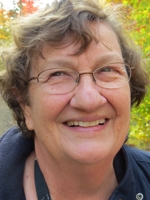
Clouds
by Joan Gibb Engel
Sadly Joan died a few days before this issue went to press. Her husband asked us to use the following:
"In the last weeks of her life Joan looked out each morning at the little garden of native Sonoran Desert plants that she had gathered in the rear of her adobe home in mid-town Tucson, and told her friends that seeing them not only connected her to the surrounding desert ecosystem, but brought back to life the Indiana Dunes where, following in the steps of pioneering field naturalist Henry Cowles, she learned the elements of ecological science and began to write her poetic ecological vision of the world."

You have to watch them
more carefully than your two-year olds
you can’t be turning away
to add a line to the poem you’ve written
or look up the spelling of ‘evanescent’
they won’t be the same when you return
chances are you’ll want to nail
that one in front, the way it glows
like a sea gull over water—
but leave your looking for an instant
pause to delete a comma
check the meaning of ‘senescence’
and its bright has turned to brooding
rain is falling in the distance
© Joan Gibb Engel

Thin Places
by Penny Harter
Penny lives in the Great Egg Harbor River watershed, about 40 minutes inland from the Atlantic Ocean, which she travels to along winding country roads through woods and marshlands. During the pandemic, meandering drives provided much inspiration for her poems, including this one.

Moments, locations, within or without the
confines of flesh and spirit, thin places call
us, whisper memories we can barely translate,
only know we need to hold them closer.
In the dark night of the bedroom, one of my
thin places wavers on the border between
sleep and waking, between dream and what
we call real—whatever real is.
Waking now and then, knowing a dream has
been seizing me, I reach for it only to feel it
drift away like smoke, into a place I cannot
reenter, a portal that will only open unbidden.
Lost loved ones visit me there, pull me into
places where I feel at home although I don’t
remember them. Unable to linger, I daily
seek thin places hiding in the natural world.
Time spent in communion with deer, or gazing
into a shallow roadside pond of clotted water
lilies as if it were a scrying mirror—when I enter
these still moments, a thin place embraces me.
I become deer, and even stagnant water holds
the sunning turtle who slides off the log into
the dark between yellowing lily pads that hint
at shortening daylight, cooler weather.
Along any path, thin places wait for us,
and we must seek them, must learn to slow
our pace and tame our fears until we find
ourselves between worlds, on our way home.
© Penny Harter

In Greenland the Ice Sheet
by Susan Cohen
Susan spends much of her time looking for birds in both the San Pablo Bay and the Bodega Bay watersheds of Northern California.

is pooling like tears
into the ocean
while we are too busy
planting the fossil beds with our own bones,
interred without ceremony.
When people die with no one to hold their hands
how can we be expected to mark the end of an ice sheet
that melted so fast—suddenly
beyond saving.
We have a surfeit of endings
we can’t embrace in our arms, griefs
that we dare not sing in congregation.
We are the sled dogs who slog along tracks,
knee deep in new ice-melt,
head-down and flooded with mourning.
All along we mistook a slippery future
for something we could walk across, the solid form of water
that began spilling
its dirges into the rhythm of waves.
Meanwhile, the gravitational field shifts over Greenland,
glaciers become waters
and oceans become troughs for the water’s dead weight.
Seas rise up and our children are stranded
in their one time to live,
the way polar bears swim now
with no place to go, exhausted
as we are.
Previously published in Catamaran Literary Reader
© Susan Cohen
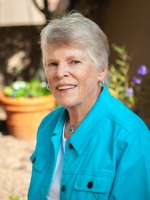
Erosion
by Janet McMillan Rives
Janet lives in the Big Wash Watershed in the Sonoran Desert of southern Arizona where she shares her tiny yard with Gila woodpeckers, vermilion flycatchers, lizards, and an occasional bobcat.

We are worn away.
We are diminished.
We've lost our edge
our sharp witty banter,
misplaced a facility to mingle.
Like shoreline cliffs
we collapse, tumble
into the ocean below.
We avoid lows and highs,
allow the wind to level us
like flattened sea dunes.
At the river's edge
our roots cling to rocks
exposed by surging water.
Where has it drifted
the silt of our lost days?
Where has it settled?
© Janet McMillan Rives

Gifts
by Janet McMillan Rives
Janet lives in the Big Wash Watershed in the Sonoran Desert of southern Arizona where she shares her tiny yard with Gila woodpeckers, vermilion flycatchers, lizards, and an occasional bobcat.

From a distance I see a flowered
clock like the one I happened upon
in Nantes during a wait between trains
a clock in reds and yellows
petunias and marigolds.
But this isn’t a flowered clock at all
but bright plastic bags filled with sand
layered along a levee
keeping surging water from our town.
Hundreds of helpers, maybe thousands,
worked into the night filling, tying,
passing, piling vivid bags at river’s edge.
It worked. Our gift to us.
Yet now we gaze across the river
at houses up to their eaves in water.
We see the river wreak its havoc
on downstream cities
making million-dollar messes
for others to clean up.
Our gift to them.
© Janet McMillan Rives

Sprouting Wand
by Anna Laura Reeve
Anna Laura Reeve lives near the Tennessee Overhill region, historic land of the Eastern Cherokee, at the confluence of the French Broad River and the Holston River, where the Tennessee river is formed.

you are like the branches of the dying peach tree
we piled in early spring by the fire ring,
bare, buds. Two weeks later,
tiny green tongues and pink flowers
festooned them.
I wanted them to stop—horrible,
in some way, for dead branches to bloom.
There they lay, not conserving
their little sap, their little dignity,
making a flowered circlet
for a grave, determined and knowing.
They moved according to the motion
of the natural world: spend what you have
on flowers, and it will return to you
seeds.
In another week,
they faded, but bees had still come
to them.
© Anna Laura Reeve

Playing the Washboard
by Anna Laura Reeve
Anna Laura Reeve lives near the Tennessee Overhill region, historic land of the Eastern Cherokee, at the confluence of the French Broad River and the Holston River, where the Tennessee river is formed.

Birdsong thins the air.
Liquid calls from cardinals criss-cross
the yard like plumes of woodsmoke
or steam from a hot cup, lit by sunrise.
I am so still
that a brown thrasher and her fledgling
alight in the garden near me
to pick through the leafmulch.
Dark chest streaks I see so rarely—
sign of a forest dweller—
another staccato, another dash of pepper.
Splattering of hackberry buds thickly
gathering overhead,
wet streaks of boxelder tassels smearing.
I wait for the rain to begin
and send me back inside.
Here in our city, and in yours, the pandemic.
Here the female bluebird,
neutral-colored, with just enough blue;
here the buzzy call of the Carolina wren
like somebody playing the washboard.
© Anna Laura Reeve
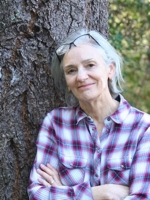
Arbor Day
by Rebecca Lawton
A younger Rebecca guided thousands of people through the Colorado River watershed on lands of the Navajo, Hopi, and others. She writes now from Sonoma Creek watershed, homeland of the Miwok, Ohlone, and Pomo.

We plant late in the day
and pray for rain
to cool the night
We dream of things we loved
Those lost in an instant:
our stepmother’s breath
the neighbor boy who fell from his roof
Neither here to face the hot days
to come, though they wanted to
Those lost over time:
bees thinned out of hives
honeysuckle dry in the sun
the foxes who denned here
Still we plant our seedlings
Slip them with hope into soil
to tend the rest of our days
Dig them in well for generations
Open our soft-earth burrows for some future
return
© Rebecca Lawton

The Grief of Crows
by Maggie Wadey
From Maggie’s desk in Hackney, East London, she looks across a park to the Olympic Site, where there's a sense of a big open sky and the Thames River, with its wide flat estuary, being within easy reach. In her narrow, city garden she has grey squirrels, foxes, a lot of cats, 'cockney' sparrows, crows and green parakeets.
Bully-boys in crumpled morning-dress,
black-pearl sheen of feather, shining-anvil beaks
pinched between glittering buck-shot eyes... city crows,
protection-racketeers, too confident to flap, swooping on open wings,
creaking, umbrella-black, close-helmeted vandals handing out death-threats
with every twist and roll, dive-bombing pigeons, magpies, starlings,
incredulous dog-walkers and their dogs.
Then, with a sudden uplift, they alight in the plane-tree’s crown beside their nest,
byword for resistance to the storm, their nestling’s airy home.
And there, with tender bleats and marble-rolls of mummy-calls they coax
their baby forth - just one this year – to tight-rope wobble on the roof-top ridge,
to bow with open begging beak, to crow, crow, crow.... until
its parents give the nod and down it goes to drop into that lush
and grassy place below, where, under the leaves,
the fox is waiting: silent, hidden, patient.
High above and out of sight, crow-daddy now forgoes
the comedy of strut and shuffle and family lullabies to throw off his fool’s motley
and, with repeated forward thrusts, from open beak he vomits forth
his warning: bass, harsh as a shovel-load of coal dumped on the air like
an evil prayer. Theatricals for the most part. Crows kill only the helpless,
small and weak, leaving the heroics of hunting still-pumping flesh
to a quite different order of beings.
Under the leaves the fox is waiting: silent, hidden, patient.
She knows her moment, knows the feather-plated toy is crunchy-soft,
snaps it up in razor-jaws, taken! and fleets away, the inky body helpless,
folded, flapping in her mouth. Swift, rust-coloured shadow,
like a thumb-print of dried blood, she paints the grass
and then is softly gone.
Crow blood freezes.
A cacophony of panic splits the air.
A choking fury of croaking, cawing, clacking, the crows’ dense-packed power
and fury a battering-ram against the senses; and every other alarm-call bird
makes common cause in tumbling, war-fuelled acrobatics.
All helpless against the vaporous cunning of the fox.
Vanished.
Like circles widening on water,
like the rings inside a tree that count the years, mourning is told
first in minutes, then half-hours, then hourly as the parents toll the fading bell until,
in silence, day after day their hunch-backed blackness haunts our trees.
The grief of crows.

© Maggie Wadey

Sand dunes
by D.S. Maolalai
D.S. lives in a small city on an island in the Atlantic, just off the European coast and in an apartment overlooking a sluggish grey river, surrounded on all sides by seagulls.

it's something a bruised
evening anyway. wind
pushing birds about
like pages arranged
on a desk. we are walking
past smithfield’s free
government housing –
watching the breeze
as it plaits our dog's hair.
the apartment’s nearby – she’s old
and can't handle a walk
in a windscape. and the buildings
show something in size
of a continent. they rise, sheer
as risen things, washing and clean
from the sea. little windows,
grey painted walls.
like naval ships, crashed
into sand dunes – men going over
with ropes. something natural
there, in this unnatural
piling – uninteresting lives
lived on top of each other. the wind
moves. from somebody's windowsill,
a radio. the kitchen
come to greet us; you can hear
the shape in music; the patterned tiles, mugs
and hanging tea-towels. a domesticity
reached out of all
this landscape. someone
sitting down,
drinking tea. we pass by slowly
and the wind pulls
like a dog against the music. we're on
the street again, and very cold.
© D.S. Maolalai

The First Last Days of Bombus Affinis
by Staci Mercado
Staci lives among the fertile soils of the Upper Mississippi region where bald eagles and red-tailed hawks rule the skies.

I wake from an afternoon nap and shuffle out to the mailbox. My sister’s voice echoes in my head: Every time I call you’re sleeping. You’ll sleep your life away. I know she’s right, but most days I don’t even make it out to the mailbox, so I’m making progress.
The wind picks up, rustling the blossoms on the crabapple tree. It shakes loose a dead bumblebee that falls to the driveway. Her six legs, dusted with yellow pollen, curl in as if hugging the stamen of a flower. Her black eyes shine, seeming curious, seeming courageous. Perfectly formed wings of chitin sprout from her fuzzy black and yellow thorax. They remain erect and ready for flight—no form of injury visible.
The first ant forager finds her and heads back to tell the others. I imagine the colony swarming her and pick her up by a wing, though I’m scared of her waking, stinging.
I forget about the mail and bring her inside. “Anyone want to see a bumblebee?” I ask.
My husband and four boys are scattered about the house. I am an insect lover, spider rescuer. They remember jars of fat wolf spiders and refuse to come. Only my youngest son responds. “You’re awake, Mama?” He comes as close as he dares, which is to say, not close at all. Arms-length. “I’m scared of bees,” he says, shudders.
We examine her together, name her parts: thorax, stinger, proboscis, compound eyes. I point out a small patch of rusty color on her abdomen. “Why do you think it’s dead?” he asks.
“I’m not sure,” I tell him, though I suspect I know why. I don’t tell him that Bombus affinis, the rusty-patched bumblebee, is endangered.
We look out into the crabapple tree, its boughs arching over the driveway where I found her. Not a bad way to die, if that was how she went—sucking nectar and collecting pollen for the family. In danger or endangered, we move. Then we drop—just like that.
“Why did you pick it up?” He dares to get a bit closer, his brown eyes widen.
“I want to remember her,” I say as I imagine a world without bees. I place her in a canning jar and leave the top off in case she’s taking a long nap and decides to sleep walk, sleep fly.
“You’re saving the bees,” he says.
The next morning our purple lilacs burst forth after evening rains, somewhere underground a bumblebee stirs, and I wake.
© Staci Mercado

Sleeping Deer in the Afternoon
by Jerome Gagnon
Jerome lives in the San Francisco Bay Area adjacent to a 15,000-acre park, home to bobcats, white-tailed deer, coyotes, raptors, and the occasional mountain lion.

I remember the sleeping deer as they awoke in the grass,
heads tilted to the scent of us —
seven or eight of them, one a fawn,
up and running through the old orchard,
flying across the creek,
disappeared in the brush.
White petals drifted by
like frail coins, as we moved
closer to where they’d lain —
bent green still warm.
I mourn the dark trunks of the apple trees;
my arms couldn’t reach around them.
The orchard uprooted: hip-curve of hill
carved into lots;
where light dripped from branches,
the stare of gravel;
no more hum of black bees,
creek trickle.
I remember the deer, their flight as our breath held
and held —
trust they found another place to sleep
and pray no one comes across it.
© Jerome Gagnon